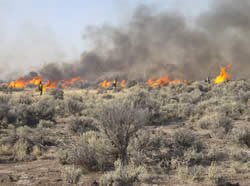
National Fire Plan Success Story
U.S. Fish and Wildlife Service Assists in Fire Research
Sheldon-Hart Mountain National Wildlife Refuge, Oregon
National Fire Plan - Fuels Reduction
2009

Firefighters lay fire on the ground as part of a Joint Fire Science Program research project to restore sagebrush steppe habitat on the Sheldon-Hart National Wildlife Refuge in Oregon. Photo courtesy USFWS.
Firefighters from the Sheldon-Hart Mountain National Wildlife Refuge in southeastern Oregon have been part of a five-year partnership with the Joint Fire Science Program study to restore sagebrush in the Great Basin, completed mid-October 2008. Firefighters from U.S. Forest Service and Bureau of Land Management also assisted.
As part of the study, researchers established test plots of sagebrush and treated them with different land management options, including mechanical thinning of shrubs, herbicide application, or burning. Other plots were left unaltered in order to determine the best way to enhance the sagebrush habitat. A total of 1,600 acres were treated as part of this study at the Refuge.
For their part, firefighters ignited the areas researchers designated as burn plots. Ignition was done primarily by hand with driptorches, which lay fire on the ground as firefighters carry them. Ignition of the site was a three-day process to help ensure the fire would stay within the designated area. On the first day, firefighters created a blackline where they burned along the edge of containment lines to create an additional buffer. The second day, they ignited the entire area within the lines. The last day was spent lighting any unburned pockets of flammable vegetation that remained.
“Burning sites like this can be tricky because the spotty nature of the fuel limits how well fire will move across the area,” said Dave Walker Assistant Fire Management Officer at the refuge. “We have to burn with enough wind to carry the flames, but without so much wind that we have issues controlling the fire.”
The refuge lies within the high desert country of the Western Great Basin, predominately covered with sagebrush and home to such species as sage grouse, mule deer and antelope.
Sagebrush has been declining on the refuge and throughout the west as non-native species such as cheatgrass take over and woody species such as juniper encroach and compete with native plants. This decline is due in part from a lack of fire occurrence in natural places, due to fire being effectively suppressed over the last several decades.